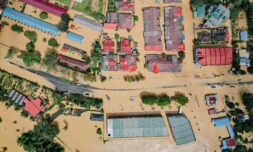Calculating the loss of life and land
The authors, Professor Ilan Noy and his colleague Rebecca Newman, adopted a statistical value of $7 million for a lost life, which is an average of the two figures used by the US and UK governments.
This may sound like a contentious approach, but it aligns with standard economic practices and is essential for making decisions about investments in various sectors.
It is also important to factor in human lives, as calculating economic damage to infrastructure alone would disproportionately skew cost estimates toward wealthy countries, despite the fact that extreme weather often impacts poorer nations.
Over the course of two decades, an astonishing 1.2 billion people were affected by extreme weather events linked to the climate crisis, with two-thirds of the financial burden attributed to fatalities. The remaining third arises from the destruction of property and other assets.
Storms account for two-thirds of the climate’s economic toll, while heatwaves contribute 16 percent, and floods and droughts contribute 10 percent.
Thanks to this combined approach, a serious contrast is exposed between the $140 billion in annual damages and the $100 billion proposed for a loss and damage fund created by wealthy countries to aid less affluent nations.
It’s also interesting to note that this figure is well below the massive $7 trillion in annual subsidies enjoyed by the fossil fuel industry.
Why quantify the economic cost of climate change?
Understanding the financial burden of the climate crisis will be a crucial tool for deciding on the amount of money needed to create a global loss and damage fund.
Establishing a loss and damage fund was a key topic discussed at Cop27 last year, with the goal of offering aid to vulnerable nations needing to recover from the aftermath of severe weather events.
Professor Noy emphasises the gravity of his $140 billion annual cost calculation against the disparity with standard climate change cost quantifications based on computer models.
It is now obvious that previous estimates have grossly underestimated the actual economic impact of the climate crisis.
Still, he recognises that his calculations are probably not exact, either. Significant challenges to understanding the true numbers are posed by the lack of data on certain extreme weather events in poorer nations, as well as missing numbers related to human casualties and infrastructure damage.
‘We have no idea how many people died from heatwaves in all of sub-Saharan Africa,’ said Professor Noy. ‘That indicates our headline number of $140 billion is [also] a significant understatement.’
There is no denying existing numbers
The world has witnessed a sevenfold surge in reported losses stemming from extreme weather disasters since the 1970s, according to the World Meteorological Organization.
This study, published in the journal Nature Communications, adopts an innovative approach to gauge the influence of climate change on extreme weather events. Still, the authors recognise the difficulty in separating the influence of global heating from factors such as population growth, urban migration, and improved disaster reporting.
With this in mind, the authors drew from hundreds of studies that assess how global heating increases the frequency of extreme weather events. This allowed for the estimation of the fraction of damages attributable to human-caused heating.
To generate the final estimates, the researchers applied these fractions to the damages recorded in the International Disaster Database, which aggregates data on disasters resulting in at least 10 deaths, 100 affected individuals, or declarations of a state of emergency or international assistance requests.
The central estimate indicates an average annual climate cost of $140 billion, with a range spanning from $60 billion to $230 billion.
What is interesting is that these estimates far surpass those derived from computer models. Computer-generated models rely primarily on notable changes in average global temperature and generally overlook the mounting extremes witnessed around the world.
The years with the highest climate-related costs include 2003, marked by a devastating European heatwave; 2008, marred by Cyclone Nargis in Myanmar; and 2010, stricken by a drought in Somalia and a Russian heatwave.
Property damage peaks at its highest in 2005 and 2017, corresponding to hurricanes that struck the United States in areas where property values are notably high.
Why the numbers are important
During the UN Climate Summit Cop27 in 2022, participating nations agreed to establish a loss and damage fund. This was aimed at helping impoverished nations rebuild in the aftermath of climate-related disasters but has yet to come to fruition.
Professor Noy emphasizes the utility of their methodology in quantifying the necessary funds for this purpose, transforming it into an insurance mechanism for countries. This methodology could also hold significance in determining damages in climate-related legal disputes.
In the eyes of Dr. Stéphane Hallegatte at the World Bank, the key takeaway is clear: climate change is undeniably increasing global economic losses from disasters.
Amidst debates over the significance of climate change, these findings provide a robust and convincing case. They underscore the need for global research centres, predominantly situated in wealthy nations, to refocus their efforts on the challenges faced by poorer countries.
The study is a resounding alarm call to the world, highlighting the urgent need for international collaboration and decisive climate action. As the numbers continue to climb, the cost of inaction is simply too high to ignore.





















